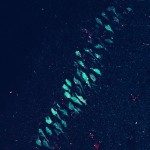Lien vers Pubmed [PMID] – 34820636
Lien DOI – 10.1016/j.crneur.2021.100018
Curr Res Neurobiol 2021 ; 2(): 100018
Nicotinic acetylcholine receptors (nAChRs) modulate the cholinergic drive to a hierarchy of inhibitory neurons in the superficial layers of the PFC, critical to cognitive processes. It has been shown that genetic deletions of the various types of nAChRs impact the properties of ultra-slow transitions between high and low PFC activity states in mice during quiet wakefulness. The impact characteristics depend on specific interneuron populations expressing the manipulated receptor subtype. In addition, recent data indicate that a genetic mutation of the α5 nAChR subunit, located on vasoactive intestinal polypeptide (VIP) inhibitory neurons, the rs16969968 single nucleotide polymorphism (α5 SNP), plays a key role in the hypofrontality observed in schizophrenia patients carrying the SNP. Data also indicate that chronic nicotine application to α5 SNP mice relieves the hypofrontality. We developed a computational model to show that the activity patterns recorded in the genetically modified mice can be explained by changes in the dynamics of the local PFC circuit. Notably, our model shows that these altered PFC circuit dynamics are due to changes in the stability structure of the activity states. We identify how this stability structure is differentially modulated by cholinergic inputs to the parvalbumin (PV), somatostatin (SOM) or the VIP inhibitory populations. Our model uncovers that a change in amplitude, but not duration of the high activity states can account for the lowered pyramidal (PYR) population firing rates recorded in α5 SNP mice. We demonstrate how nicotine-induced desensitization and upregulation of the β2 nAChRs located on SOM interneurons, as opposed to the activation of α5 nAChRs located on VIP interneurons, is sufficient to explain the nicotine-induced activity normalization in α5 SNP mice. The model further implies that subsequent nicotine withdrawal may exacerbate the hypofrontality over and beyond one caused by the SNP mutation.

